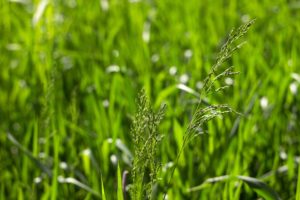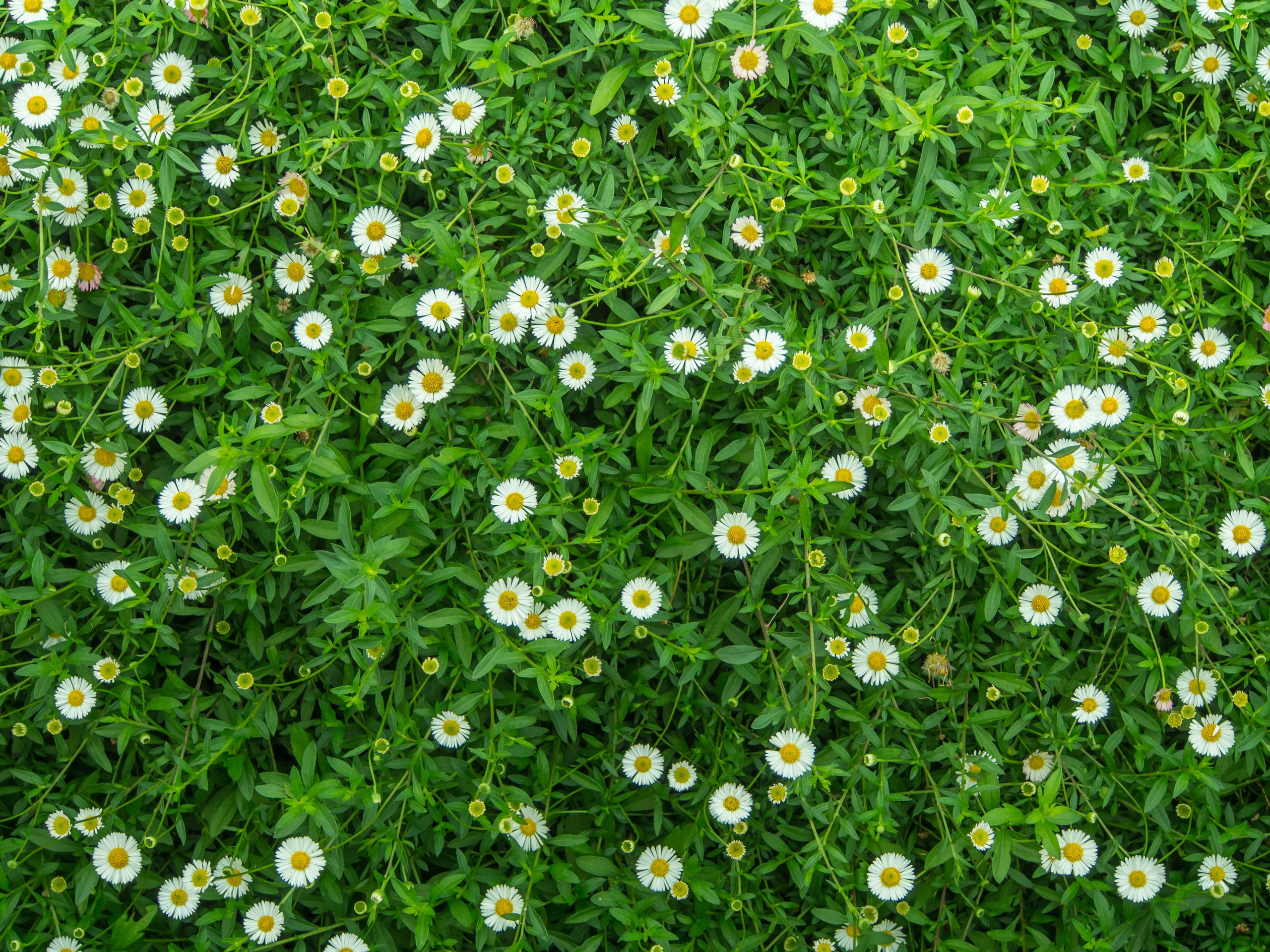What is Lawn Grass?
A lawn is a piece of land where grass grows. Grass grown in a landscape is called a lawn. Grass that is grown on a golf course or baseball field is called turf.
Horticulturists refer to grass that is mowed and maintained as turf, and it has the same uses as a lawn.
Lawn grass is similar to all plants in the ecosystem. Almost all plants flower so they can reproduce.
Does lawn grass flower?
Yes, it does! Grasses have flowers called florets. Florets grow in small clusters called spikelets that together form inflorescences. The flowers produce spores, and by these, they pollinate with other flowers to produce seeds. Some of these seeds will grow into new grass plants.
However, it won’t be beneficial to your lawn – quite the opposite. Grass flowers do more harm than good. Instead, you should keep your grass well-maintained with regular mowing, watering, and fertilizing.
Grasses come with a simple structure:
• Threadlike or fibrous roots
• Culms or grass stems
• Narrow leaves (the thin part is the sheath, and the upper part is the blade)
• Flowers- florets.
The grass is essential in the landscape because of its aesthetic appeal. It also contributes to the environment by catching runoff water, protecting the soil from erosion, and reducing heat irradiation and dust. Grass also serves as a natural carpet in homes and recreational sports venues.
Attractive and healthy lawns begin with having suitable turf grass that is properly installed and well-maintained. Lawn grass can be established from vegetative plants and seeds.
How does Lawn Grass Reproduce?
Lawn grass needs to reproduce so their species will thrive. They have two methods of reproduction:
• Side Tillering
This is when the mother plant produces a stem. The stem crawls above the ground (stolons) or below the ground (rhizomes) and produces new grass plants. The stolons or rhizomes nurture the new grass plants until they mature and can survive on their own.
• Seed Production
Lawn grasses produce florets or flowers that produce pollen grains. The wind carries the pollen grains, and they pollinate other grasses to produce seeds. Many of these new seeds grow into new grass plants.
Many turfgrasses start seeding in the spring because of the longer days and warm temperatures. Most of these seeds will not reproduce because they need to remain on the stalk for about 4 months before they can produce a worthwhile seed. They need to be adequately fertilized to produce viable seeds.
Grass Seed Production
The term inflorescence refers to a cluster of flowers that produce grass seeds. Flowers in grass species are developed once they have enough leaf blades. The stems of grass elongate once it reaches the correct size. Inflorescences are then developed due to sun exposure and temperature.
Grass flowers can have female and male reproductive organs in separate flowers or together. Once fertilized with pollen, these flowers produce seeds from a compatible grass flower.
Seeds develop in the ovaries of the flower when their pollen gets fertilized. Pollen is transferred to female flowers from male flowers through the wind or insects.
Some grass species produce seeds through apomixes (asexual reproduction of a viable seed without fertilization). This means that the ovary is stimulated by pollen release when not fertilized. The seed produces a clone or duplicate of the parent plant.
Seed Heads and Flowering
All grasses produce a seed head and flowers. Growing seed heads and flowers are part of the regular life cycle of all plants.
Fertilizing your lawn with nitrogen is one of the ways to reduce the number of seeds and flowers. Nitrogen will stimulate the growth of more shoots and leaves. It will also keep the plants from producing many seed heads.
Why are there Flowering Grass Heads in your New Lawn?

What Happens When Grass Flowers?
As mentioned above, lawn grass, just like any plant, needs to reproduce. Seed production is one way for them to reproduce. Seed production happens during spring. This is also the time when most homeowners make an effort to make their lawns look lush and green.
Newly laid grass produces more seeds. Grasses get stressed when they are cut. Most of their roots that provide water and food get severed. As a result, grasses go into self-preservation mode and produce a lot of seeds.
The moment your grass re-establishes a healthy root system, seed production will reduce, mainly if your lawn receives enough water and nutrients and is well-maintained.
Regularly mowing your lawn prevents grass from seeding itself because the grass is not able to produce seeds if they do not develop flowers. Allowing your grass to grow high will make them bloom and go to seed.
Should you let Lawn Grass Seed?
Grass plants such as fall fescue, perennial ryegrass, and Kentucky bluegrass begin to seed in the spring.
It is a common thing for homeowners sometimes to be lazy about mowing their lawns. Mowing can be a time-consuming and tedious task. Often, it is incredibly tempting just to leave the grass to grow, grow, and grow!
The thing is, if you leave the grass to continue growing, it will seed and make its long blades tough on your lawnmower and your entire yard. Allowing your lawn to seed itself is different from planting new grass seed. New grass seeds create new lush lawns. Allowing them to seed will not.
There are three primary disadvantages of letting grass seed itself:
• Seed Creation Diverts Energy from the Grass
When you allow your lawn to go to seed, you are making the grass divert its energy to flowering rather than growing healthy and strong. It also signals the grass not to produce many rhizomes and stops it from repairing itself. This will make your lawn look ugly.
• Seed Creation Weakens the Grass
Regular mowing keeps your grass healthy and robust. Letting your grass grow very high will make it go to seed and create more harm than good.
• Eliminates Weed Control
Weeds in your lawn can be highly irritating. They quickly grow and can get very tough to remove from your lawn. Weeds will thrive on your property when you allow your grass to go to seed. Mowing not only cuts down the weed, but it also weakens them and prevents them from growing back. Allowing weeds to rise high in your yard will make them fill your lawn with broader weeds than ever.
Grass will typically go to seed under stressful conditions, often because of lack of nutrients and water. Although making your grass go to seed is not bad for your lawn, it will not look beautiful and feel soft underfoot.
It can be pretty easy to avoid growing seed heads on your lawn. A regular lawn care program, including regular mowing, watering, and fertilizing, will not allow your lawn to go to seed throughout the year.
Typically, lawns stop going to seed on their own after a few weeks. In an extreme change in weather, your lawn will stop going to seed once the temperature goes back to normal or when the grass has adjusted to the weather.
In circumstances when weather conditions are relatively consistent, yet your lawn does not stop seeding, it may be experiencing some stressful situations such as lack of nutrients, water, or soil composition.
Final Thoughts
So there you have it—a straight answer to a straightforward question. Don’t let your lawn grass flower.
The more knowledge you can accumulate about the maintenance of lawns, the better your own lawn will be. It could be through your diligence and loving labor on your land or through your directions given to your garden service on how to utilize these guidelines on your property.
It doesn’t matter, just as long as the things you’ve learned about how to create a superior lawn and garden are put into action so that you and your family can benefit from them.
Jenny Marie
Tribal Writer
Edited By
Patricia Godwin

